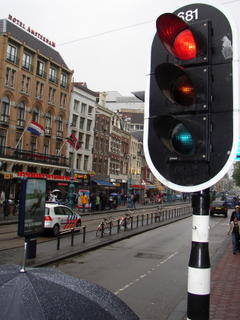Walls

Amsterdam is virtually synonymous with its Red Light District -- a section of the city center popularized by its institutional prostitution and regulated "soft drug" industry. Tourists flock to the ancient streets in the vicinity of the Oude Kerk, essentially "window shopping" among the sex cinemas and brothels -- each such establishment marked by red lights hung outside the main entrance. The smell of marijuana is heavy in the air outside of the smoking "coffee shops," and eager wanderers devour the sights and smells of this infamous district in this infamous city. To the locals, this corner of the city is known as de Wallen ("the Walls") -- so dubbed because of the major canals and streets running through the district with names like the Nieuwzijds Voorburgwal and the Oudezijds Achterburgwal. Such names originated in pure practicality, referring to the embankments along the side of the earliest canals dug out around the original dam, diverting the flow of the Amstel River. Yet de Wallen have taken on a figurative meaning as well, representing the city's notorious vices: walls of idolatry, walls of segregation, walls of separation between sinful society and righteous society.
Amsterdam's identity is wrapped up in de Wallen. For better or worse, the city is celebrated and despised for its moral relativism, sexual libertarianism, and tolerance for any and every whim of the almighty individual. The rest of the world grins devilishly or offers a scolding "tsk, tsk" feeling better about their own society's restraint from the Walls of Amsterdam's evils.
Yet de Wallen are not merely an Amsterdam phenomenon, or a purely Dutch vice. Case in point: New Amsterdam. Founded in the New World at the mouth of the Hudson River, upon a stretch of land known as Manhattan, the settlement quickly developed into a major center of commerce. Eventually the British gained control from the Dutch -- renaming the city New York -- and still later, the Americans won independence to make New York their own. But the city retained many artifacts from its Dutch roots -- Haarlem became Harlem, Breukelen became Brooklyn, Stateneiland became Staten Island... and the name for Nieuw Amsterdam's section of the city known as de Wallen eventually became Wall Street.
Ironically, like the implicit connection between Old Amsterdam and its Red Light District, New York is practically synonymous with its Wall Street -- a section of the city center popularized by its ruthless capitalism and industrial oligarchy. Tourists and tycoons flock to the skyscrapers in the vicinity of the New York City Stock Exchange, essentially driving the world's market economy. The air is heavy with cellular telephone signals and the whir of corporate machinery, and eager wanderers devour the power and prestige of this infamous district in this infamous city. More than an artifact of early Dutch colonialism, the name Wall Street has taken on a figurative meaning as well, representing the city's more subtle vices: walls of idolatry, walls of segregation, walls of separation between greed and righteousness.
New York's identity is wrapped up in Wall Street. For better or worse, the city is celebrated and despised for its cunning negotiations, high-powered business transactions, and reckless abandon in the pursuit of the almighty dollar. The rest of the world grins devilishly or offers a scolding "tsk, tsk" feeling better about their own society's restraint from the Walls of America's evils.
Indeed, the Walls crowd us on every side. Amsterdam, New York, Beijing, Sao Paolo, Johannesberg, Melbourne... No matter the society, no matter the practical outworkings, we are suffocating behind the Walls of wickedness and moral decay.


3 Comments:
Really cool insight. Sometimes it is much easier to see certain sins than others. The Red Light district, now that is bad. But, starving people, neclecting your family, and doing anything so you can buy your 3rd boat and 17th car...no big deal to me. Something doesn't add up.
It is fascinating to discover the parallels. When I heard about the connection between the name for de Wallen and Wall Street, it seemed to confirm something that had been on my mind for quite awhile.
When I tell Americans that I'm working for a church in Amsterdam, the response is generally something to the effect of "Wow, that's great. They really need God in that society" (and I'm certainly not contesting this point!)... But we can so easily ignore the sins of our own society.
Dutch people really don't seem to think that much of the Red Light District, but they can so easily criticize the evils of "America's corporate imperialism" -- including things like you mentioned, Bryan, as well as presumed causes for wars in the Middle East and support of unfair labor practices (like you so often point out, Seth).
I guess we're just naturally blind to our own sin and hyper-sensitive to the sins of others. Splinters definitely have to be removed from the eyes of society -- but each man must worry first about the plank in his own eye.
fascinating! That is seriously an amazing parallel world colliding thousands of miles apart.
Post a Comment
<< Home